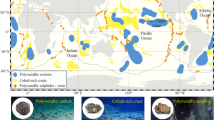Abstract
An in situ calibration system is a versatile exploration instrument for electrochemical sensors investigating the biochemical properties of the marine environment. The purpose of this paper is to describe the design of an auto-calibrating system for electrochemical (pH) sensors, which permits two-point in situ calibration, suitable for long-term measurement in deep sea aqueous environments. Holding multiple sensors, the instrument is designed to perform long-term measurements and in situ calibrations at abyssal depth (up to 4000 m). The instrument is composed of a compact fluid control system which is pressure-equilibrated and designed for deep-sea operation. In situ calibration capability plays a key role in the quality and reproducibility of the data. This paper focuses on methods for extending the lifetime of the instrument, considering the fluidics design, mechanical design, and low-power consumption of the electronics controller. The instrument can last 46 d under normal operating conditions, fulfilling the need for long-term operation. Data concerning pH measured during the KNOX18RR cruise (Mid-Atlantic Ridge, July-August, 2008) illustrate the desirable properties of the instrument. Combined with different electrodes (pH, H2, H2S, etc.), it should be of great utility for the study of deep ocean environments, including water column and diffuse-flow hydrothermal fluids.
Similar content being viewed by others
References
Benini, L., Bogliolo, A., Micheli, G.D., 2000. A survey of design techniques for system-level dynamic power management. IEEE Transactions on Very Large Scale Integration (VLSI) Systems, 8(3):299–316. [doi:10.1109/92.845896]
Benini, L., Castelli, G., Macii, A., Scarsi, R., 2001. Batterydriven dynamic power management. IEEE Design & Test of Computers, 18(2):53–60. [doi:10.1109/54.914621]
Bradley, A.M., Ivey, M.K., Liberatore, S.P., Duesteret, A.R., 1995. Development and testing of thermocouple/thermistor array packages for monitoring temperature at hydrothermal vent sites. Eos Transactions American Geophysical Union, 71:411.
Chen, C.A., Wang, S.L., Chou, W.C., Sheu, D.D., 2006. Carbonate chemistry and projected future changes in pH and CaCO3 saturation state of the South China Sea. Marine Chemistry, 101(3–4):277–305. [doi:10.1016/j.marchem.2006.01.007]
Chen, M., Rincón-Mora, G.A., 2006. Accurate electrical battery model capable of predicting runtime and I–V performance. IEEE Transactions on Energy Conversion, 21(2):504–511. [doi:10.1109/TEC.2006.874229]
Chen, O.T., Wang, S., Wu, Y., 2003. Minimization of switching activities of partial products for designing low-power multipliers. IEEE Transactions on Very Large Scale Integration (VLSI) Systems, 11(3):418–433. [doi:10.1109/TVLSI.2003.810788]
Chen, Y., Ye, Y., Yang, C.J., 2005. Integration of real-time chemical sensors for deep sea research. China Ocean Engineering, 19(1):129–137.
Dickson, A.G., 1993a. The measurement of sea water pH. Marine Chemistry, 44(2–4):131–142. [doi:10.1016/0304-4203(93)90198-W]
Dickson, A.G., 1993b. pH buffers for sea water media based on the total hydrogen ion concentration scale. Deep Sea Research Part I: Oceanographic Research Papers, 40(1):117–118. [doi:10.1016/0967-0637(93)90055-8]
Ding, K., Seyfried, W.E.Jr., 2007. In situ measurement of pH and dissolved H2 in mid-ocean ridge hydrothermal fluids at elevated temperatures and pressures. Chemical Reviews, 107(2):601–622. [doi:10.1021/cr050367s]
Ding, K., Seyfried, W.E.Jr., Zhang, Z., Tivey, M.K., von Damm, K.L., Bradley, A.M., 2005. The in situ pH of hydrothermal fluids at mid-ocean ridges. Earth and Planetary Science Letters, 237(1–2):167–174. [doi:10.1016/j.epsl.2005. 04.041]
Kumar, A., Bayoumi, M., Elgamel, M., 2004. A methodology for low power scheduling with resources operating at multiple voltages. Integration, 37(1):29–62. [doi:10.1016/j.vlsi.2003.09.005]
Le Bris, N., Sarradin, P.M., Pennec, S., 2001. A new deep-sea probe for in situ pH measurement in the environment of hydrothermal vent biological communities. Deep Sea Research Part I: Oceanographic Research Papers, 48(8):1941–1951. [doi:10.1016/S0967-0637(00)00112-6]
Le Bris, N., Sarradin, P.M., Caprais, J.C., 2003. Contrasted sulphide chemistries in the environment of 13°N EPR vent fauna. Deep Sea Research Part I: Oceanographic Research Papers, 50(6):737–747. [doi:10.1016/S0967-0637(03)00051-7]
Le Bris, N., Zbinden, M., Gaill, F., 2005. Process controlling the physico-chemical micro-environments associated with Pompeii worms. Deep Sea Research Part I: Oceanographic Research Papers, 52(6):1071–1083. [doi:10.1016/j.dsr.2005.01.003]
Orr, J.C., Fabry, V.J., Aumont, O., Bopp, L., Doney, S.C., Feely, R.A., Gnanadesikan, A., Gruber, N., Ishida, A., Joos, F., et al., 2005. Anthropogenic ocean acidification over the twenty-first century and its impact on calcifying organisms. Nature, 437(7059):681–686. [doi:10.1038/nature04095]
Pan, Y.W., Seyfried, W.E.Jr., 2008. Experimental and theoretical constraints on pH measurements with an iridium oxide electrode in aqueous fluids from 25 to 175 °C and 25 MPa. Journal of Solution Chemistry, 37(8):1051–1062. [doi:10.1007/s10953-008-9293-z]
Reimers, C.E., Glud, R.N., 2000. In situ Chemical Sensor Measurements at the Sediment-water Interface. In: Varney, M. (Ed.), Chemical Sensors in Oceanography. Gordon and Breach Publishing, Amsterdam, p.249–282.
Schweighofer, B., Raab, K.M., Brasseur, G., 2003. Modeling of high power automotive batteries by the use of an automated test system. IEEE Transactions on Instrumentation and Measurement, 52(4):1087–1091. [doi:10.1109/TIM.2003.814827]
Zhao, W., Chen, Y., Yang, C.J., 2009. Design of low-power data logger of deep sea for long-term field observation. China Ocean Engineering, 23(1):133–144.
Author information
Authors and Affiliations
Corresponding author
Additional information
Project supported by National Natural Science Foundation of China (No. 40637037), the National High-Tech Research and Development Program (863) of China (No. 2007AA091901), the National Science Foundation of U.S. (No. 0525907), and the China Scholarship Council (No. 2009632124)
Rights and permissions
About this article
Cite this article
Tan, Cy., Jin, B., Ding, K. et al. A long-term in situ calibration system for chemistry analysis of seawater. J. Zhejiang Univ. Sci. A 11, 701–708 (2010). https://doi.org/10.1631/jzus.A0900643
Received:
Accepted:
Published:
Issue Date:
DOI: https://doi.org/10.1631/jzus.A0900643




